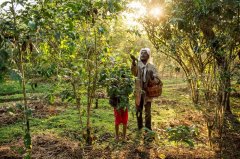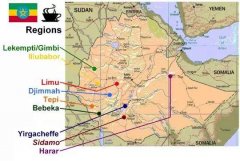Ethiopia Coffee bulk Commercial Bean producing area: Jinbi / Lekemp 05

Ethiopia Coffee bulk Commercial Bean producing area: Kinby / Lekemppi
Altitude: 1500-2100 m
Forest / semi-forest coffee system
The names of the producing areas around the cities of Ghimbi and Lekempti often appear together. Coffee roasters can use either or both. Lekempti is the capital of the region, but coffee beans with that name may come from the city of Ghimb, 100km away.
Growing in western Ethiopia, 4900-5900 feet (Wollega province) plateau, north of Jima, mostly wild, annual output is about 500000bags/60kg, export is mostly G5/G4, bean body is larger and longer than Longberry, a little brown in green, taste similar to less jasmine tea, more bitter, lack of rising Hara, slightly sour, slightly fruity and wine aroma, but slightly inferior to Hara, but with good texture and viscosity. So the beans in Jinbi District are jokingly called "poor man'". S Harar ".

The taste is complex but balanced, it has better throat rhyme in deep culture, and Huigan is longer, which is one of the materials that many bakers like to use as comprehensive beans.
Of course, it can also be used as a good single product, suitable for drinking after a meal.
The above is some related information about Qianjie coffee arrangement.
I hope this article will help you to know more about coffee.
.
Important Notice :
前街咖啡 FrontStreet Coffee has moved to new addredd:
FrontStreet Coffee Address: 315,Donghua East Road,GuangZhou
Tel:020 38364473
- Prev

Ethiopian pastoral coffee cultivation system coffee bean cultivation system distributed in Ethiopia
(photo from: national Geographic Chinese website Photo: Amivitale,Panos) according to Qianjie Coffee Consulting, 90% of coffee in Ethiopia comes from pastoral, forest and semi-forest, but large-scale corporate cultivation is rare in Ethiopia. According to the scale and model, the cultivation of Ethiopian coffee can be divided into four types: 1, forest coffee Forest C
- Next

Ethiopia Coffee bulk Commercial Bean producing area: Gima 06
Altitude: 1350-1850 m forest / semi-forest system harvest time: November-January of the following year Gima is located in the southwestern highlands of Egypt (at the junction of Kaffa and Illubabor provinces), with an elevation of 4400-6000 feet, it is the largest coffee-producing area in Egypt, accounting for 3% of exports. The fine JIMA washed in water does not have the orange fragrance and flower rhyme of Yega Xuefei, but the taste spectrum is also quite clean and clear.
Related
- Beginners will see the "Coffee pull flower" guide!
- What is the difference between ice blog purified milk and ordinary milk coffee?
- Why is the Philippines the largest producer of crops in Liberia?
- For coffee extraction, should the fine powder be retained?
- How does extracted espresso fill pressed powder? How much strength does it take to press the powder?
- How to make jasmine cold extract coffee? Is the jasmine + latte good?
- Will this little toy really make the coffee taste better? How does Lily Drip affect coffee extraction?
- Will the action of slapping the filter cup also affect coffee extraction?
- What's the difference between powder-to-water ratio and powder-to-liquid ratio?
- What is the Ethiopian local species? What does it have to do with Heirloom native species?

